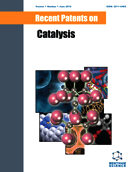Abstract
In this paper, the recent advances in the preparation of biogenic material by catalysis pathway and the patents obtained by different researchers are discussed in detail. The patents obtained by utilizing the weed biomass are scarce. The catalysis of crude plant cellulose using 2, 2, 6, 6-tetramethyl-piperidine-1-oxy radical (TEMPO) in the presence of sodium bromide and sodium hypochlorite at alkaline pH 10 producing nanofibers is relatively a new method used in the conversion of biomass into biogenic material. The aquatic weed plant cellulose available in a great deal, is otherwise a un utilized biomass. The water insoluble fractions of TEMPO oxidized cattail cellulose fibers (TEMPO-OCCF) are converted into the solubilized fractions of TEMPO oxidized cattail cellulose nanofibrils (TEMPO-OCCNF) by ultrasonication and filtration. The scanning electron micrographs (SEM) indicated that the morphology nanofibrils have 20 nm diameter and the lengths in few micrometers. Differential scanning calorimetry (DSC) results show that the TEMPO treated fibers have enriched with higher thermal stability comparable to untreated cattail fibers. A neat and transparent thin film was prepared by casting the suspension of TEMPO-OCCNF into a Petri dish. The transmittance of the film was confirmed by UVVisible spectrophotometer.
Keywords: Cattail fibers, nanofibrils, TEMPO, transparent thin film.
 18
18

